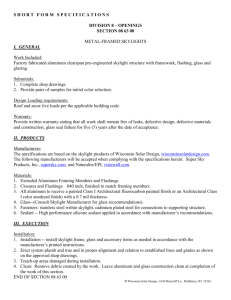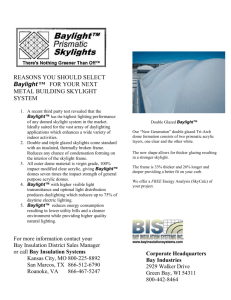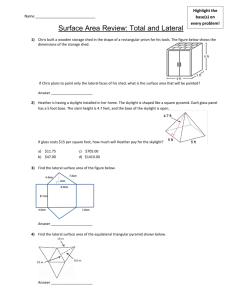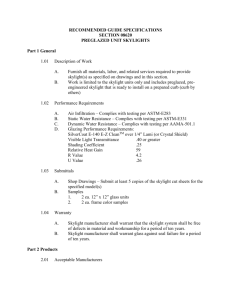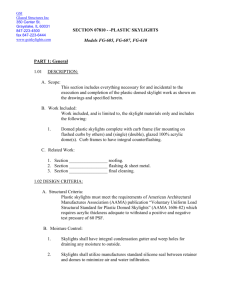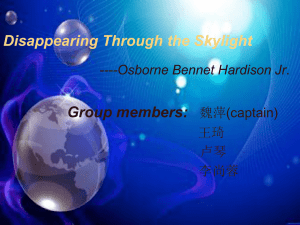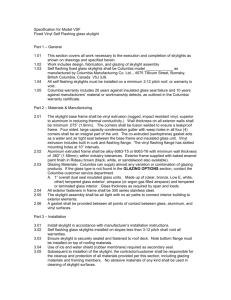VALUE ENGINEERING AND DESIGN
advertisement
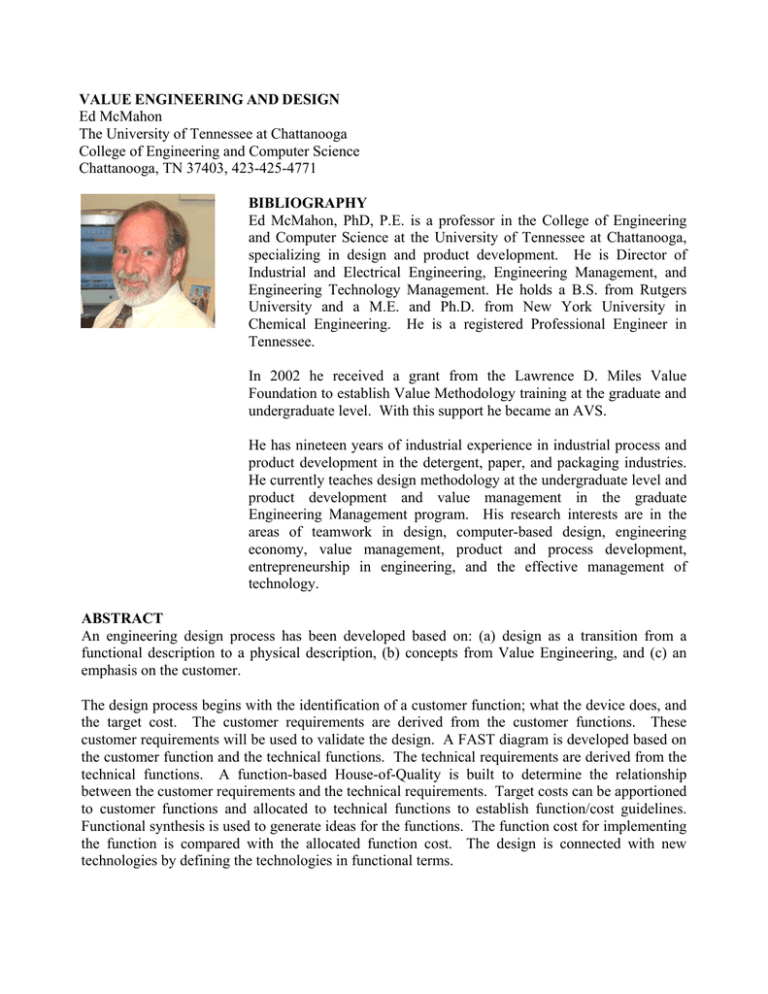
VALUE ENGINEERING AND DESIGN Ed McMahon The University of Tennessee at Chattanooga College of Engineering and Computer Science Chattanooga, TN 37403, 423-425-4771 BIBLIOGRAPHY Ed McMahon, PhD, P.E. is a professor in the College of Engineering and Computer Science at the University of Tennessee at Chattanooga, specializing in design and product development. He is Director of Industrial and Electrical Engineering, Engineering Management, and Engineering Technology Management. He holds a B.S. from Rutgers University and a M.E. and Ph.D. from New York University in Chemical Engineering. He is a registered Professional Engineer in Tennessee. In 2002 he received a grant from the Lawrence D. Miles Value Foundation to establish Value Methodology training at the graduate and undergraduate level. With this support he became an AVS. He has nineteen years of industrial experience in industrial process and product development in the detergent, paper, and packaging industries. He currently teaches design methodology at the undergraduate level and product development and value management in the graduate Engineering Management program. His research interests are in the areas of teamwork in design, computer-based design, engineering economy, value management, product and process development, entrepreneurship in engineering, and the effective management of technology. ABSTRACT An engineering design process has been developed based on: (a) design as a transition from a functional description to a physical description, (b) concepts from Value Engineering, and (c) an emphasis on the customer. The design process begins with the identification of a customer function; what the device does, and the target cost. The customer requirements are derived from the customer functions. These customer requirements will be used to validate the design. A FAST diagram is developed based on the customer function and the technical functions. The technical requirements are derived from the technical functions. A function-based House-of-Quality is built to determine the relationship between the customer requirements and the technical requirements. Target costs can be apportioned to customer functions and allocated to technical functions to establish function/cost guidelines. Functional synthesis is used to generate ideas for the functions. The function cost for implementing the function is compared with the allocated function cost. The design is connected with new technologies by defining the technologies in functional terms. This function-based methodology deviates in seemingly small ways from traditional design methodology but the continuous thread of functions enhances the design process. INTRODUCTION In many prescriptive methods of design, such as Pahl and Beitz [3] and VDI 2221 [4], the first phase of the design process is the problem clarification/needs analysis. The main emphasis is on understanding the problem and developing design requirements. The conceptual design includes functional analysis, concept generation, and selecting a concept. In function-based design, the design process starts with functions. The initial input is the customer's definition of what the device does. From the designers point of view this defines the task function. It is then up to the designer to formulate the problem in terms of the technical functions and the requirements of the system. The approach is similar to a scenario outlined by Cross [1] where establishing functions precedes setting requirements. The method is focused on the customer and combines techniques associated with traditional design methodology, value engineering, target costing, and quality function deployment. BACKGROUND Design Model Design can be considered as a transformation from a functional description to a physical description. The model suggests starting with the customer inputs to the design process, generation of a functional description, transforming the functional description to a physical description at the conceptual, layout, and finally the detail design level. Customer Technical Inputs Requirements Input INFORMATION PROCESSING ACTIVITY Functional Description Physical Description TRANSFORMATION Output Best at Each Stage Detail Manufacturing Design Instructions Figure1: Design as a Transformation Process Emphasis on Customer Function-based design is also based on a model of the importance of the customer in the design process. The customer is both a supplier of information and the evaluator of the results. The concept of users as suppliers of information and also as consumers is consistent with a lifecycle model of design where the customer defines the needs and ultimately evaluates and uses the results. The customer input on what they want the design to do and the desired level of performance is used directly in the Functional Analysis and Systems Technique and in identifying customer requirements. Value Engineering Value Engineering is a structured problem solving technique which was originally aimed at reducing cost. The modern versions of the technique include performance and an emphasis on the customer. "The single objective of modern value analysis is to deliver to the user/customer the required functions at minimum cost." [2]. The primary component of the technique applied in function based design is the Functional Analysis and Systems Technique (FAST). This technique is a means of organizing functions. The emphasis of defining the functions of the design is what the design does rather than what it is. The functions are organized into a FAST diagram. The customer-based FAST diagram is used with some modification. The diagram used is a customer-based FAST diagram that is based on the process not the device. For example, the function of a hair dryer is to dry hair. The FAST diagram for the task function, Dry Hair, looks at the process for drying hair not just what the product, a hair dryer, does. Functions are organized into a task function, which is the one that fulfills the overall need of the user, the basic functions, which are essential for the task function, supporting functions, which are essential for acceptance of the design, and subfunctions which add more detail to the functions by answering the question "How?". Some of the supporting functions and subfunctions are identified as technical functions. Target Costing Target costing is a structured approach to determine the lifecycle cost at which a proposed product with a specific functionality and quality must be produced to generate the desired level of profitability over its life cycle when it is sold at the anticipated selling price. [5] The principles of target costing are: • Know what the project will cost before it is designed • Design team must meet cost goals • Goals based on customer needs and company profitability • Cost drives the design • Product must work at a defined cost The process involves setting cost targets for the major functions related to the subassemblies. This is the responsibility of the design engineer. Function-Based Methodology The first step is to define the customer functions and the task function, what the process or device does from the customers’ point of view. The functions are expanded using the customer-based Functional Analysis System Technique or FAST diagram [2]. In function-based design, many requirements can be derived from the functions in the FAST diagram. These requirements are related to the function. For example, consider the function "move device". The requirements associated with this function include speed, distance, direction, and position. Customer requirements are derived from the functions identified from the customers’ point of view. These customer requirements are used to validate the design. The technical functions are those functions that are required from a technical point of view to achieve the customer functions. Technical requirements are derived from the technical functions identified in the FAST diagram. Theses technical requirements are used to verify the design during the design process. The outputs from the Problem Definition phase are the customer functions, technical functions, a FAST diagram, customer requirements, and technical requirements. Based on this effort a design objective and goals are defined. In the Conceptual Design Phase the functions, already defined and organized in the Problem Definition, are used to generate ideas using functional synthesis. The principal of functional synthesis is to continue to ask the question "How?" for each of the functions and generate as many ideas as possible. While the ideas are not solution principles yet, they serve the purpose of stimulating creativity and when combined with other ideas will lead to solution principles. The customer requirements, defined in the Problem Definition, are used to screen the solution principles and decide on a conceptual design. House of Quality The House-of-Quality is one of the Quality Function Deployment tools. It provides a linkage between the customer attributes, the performance the customer desires, and the design parameters or engineering characteristics. The customer and technical functions, the customer and technical requirements, and the target costs are captured in a modified House-of-Quality. Target costs could also be allocated to the technical function cost similar to the method of allocating costs to functions in a function vs. cost matrix [7]. EXAMPLE An example will be used to illustrate the design methodology based on functions. The example is based on a project conducted in a product development class. The focus of the project was to produce an improved residential skylight. The target cost for the skylight was estimated to be $150 based on a selling price of approximately $250. The selling price was estimated based on existing products on the market and an estimate of the product costs for these products. Figure 2: Skylight with curb mounting Problem Definition The initial step is to identify the customer functions, what the customer wants the product or process to do. These are the functions from the customers’ point-of-view. For the skylight, these were light environment (task function), transmit light, resist elements, create atmosphere, enhance appearance, and install skylight. The second step is to derive the customer requirements based on the customer functions. These customer requirements are used to validate the design from the customers’ point of view. These are illustrated below. Transmit light Size of skylight Brightness of light Resist elements No leaks No UV Clarity Create atmosphere Softness of light Dispersion of light Enhance appearance Location of skylight Finish of skylight Install skylight Ease of installation Time to install The next step is to identify the technical functions. These functions identify what the designer has to do to support the customer functions or satisfy other requirements such as codes and regulations or for manufacturability. Some of these functions are insulate heat, fit structure, ease installation, and access environment. Another overall technical function is to select materials. As with the customer requirements derived from the customer functions, technical requirements can be defined for the technical functions. Insulate heat Degree of insulation Type of insulation Thickness of insulation Fit structure Location of skylight Dimensions of structure Select material % Transmittance Resistance to discoloration Resistance to erosion Light filtering properties UV transmission As indicated earlier the customer FAST diagram is viewed from the customer point of view and is more of a process view than a product view. This is important in product development because some of the major product improvements are based on looking at the process and having the product perform the function instead of the user. For example, some skylights come with shades that the user has to deploy when the light is too bright. A product could be designed that automatically deployed shades or the product could be made of material that automatically changed properties in bright sun like some sunglasses do. It is necessary to verify the diagram by asking the questions "How?" and "Why?”. There should be a clear flow in both directions. For example, prevent leaks. If the question "Why?" is asked the answer is to ensure dependability. If the question "How?" is asked of prevent leaks the answers are minimize joints and seal joints. The process ends when the answer to the “How?” question is no longer solution neutral. The results of the exercise are shown in Figure 3. The diagram has been simplified for clarity. WHY? HOW? Generate Light Transmit Light Access Environment Maintain Clarity Assure Dependability Prevent Leakage Resist Weather Ease Installation Light Environment Assure Convenience Fit Structure Enhance Appearance Satisfy User Create Atmosphere Filter Light Attract User Insulate Heat Soften Light Figure 3: FAST Diagram for Function "Light Environment" The functions and the customer and technical objectives are captured in the function-based Houseof-Quality. The customer functions and customer requirements are on the right side where customer attributes are usually listed. The customer requirements are weighted based on the relative importance of the requirement to the customer. The technical function and technical requirements are captured along the top of the diagram. A roof could also be added and other features such as comparing the current product to competitors and a new product design on the right side and setting target performance values for the technical requirements on the bottom. The diagram is kept simple here for clarity. The latest development was to add the target cost to the customer functions and also to try to estimate the target cost for the technical functions. The results are shown in Figure 4. 0.4 Resist Elements 0.25 Create Atmosphere 0.1 Enhance Appearance 0.15 Install Skylight 0.1 Size of Skylight $60 Brightness No leakage No UV $38 Clarity Softness $15 Dispersion Location $23 Finish Ease of installation $15 Time to install 6 6 6 Connect Skylight # Tools required Time to install $9 Interference Distance Tolerences Dimensions 6 9 Dimensions Integrate Skylight $8 Cut Hole(roof) $20 Location # Joints Impact resistance Softness of light transmission UV Transmission Light Filtering prop. Resistance to errosion Resistance to Yellowing % Transmittance Target Function Cost Relative Importance Transmit Light # or Pieces Assemble Skylight $16 Select Materials $98 9 6 6 6 9 3 9 9 9 6 9 9 3 3 6 9 9 6 6 6 6 6 6 9 9 9 3 3 9 9 3 3 Figure 3: Function-based House-of-Quality Conceptual Design Functions are generated in the conceptual design phase in traditional prescriptive methodologies. In function-based design the functions have already been defined and organized. The functions are used to generate ideas (Functional Synthesis), functions may be organized by a necessary sequence (Function Structures or Functional Analysis), and functions may be used as a means of technology transfer. The idea of Functional Synthesis is to continue to ask the question how about each of the functions. As many alternatives as possible should be generated for each of the functions. This is best done by divorcing oneself from the problem at hand and thinking only of the function in as many contexts as possible. This promotes lateral thinking. FUNCTION IDEAS SOLUTION PRINCIPLE For example, transmit light can be considered in a variety of applications and result in a list like: Clear glass Bronze tinted glass Double glass Acrylic Heat mirror glass Wire glass Safety glass Low Emissivity Glass Polycarbonate Stainless steel rings Auxiliary light kit Prismatic diffuser Metalized Mylar Impact glass While these are not solution principles, they serve the purpose of stimulating creativity and when combined with other ideas will lead to solution principles. In the case of the skylight, even though the problem was aimed at transmitting, both the type of material and the design of the frame must be considered to provide the light and to ease installation and prevent leakage. The students in the class developed a design with about half of the target cost and a product that was easy to produce and easy to install Another use of functions in the Conceptual Design is to consider new technology for possible linkage with the desired function. Normally technologies are defined as what they are and not what they do. For example, we talk about vapor deposition as a scientific entity but seldom by what it does, i.e. apply material, finish surface, or enhance aesthetics. Asking the question "Why?" for technologies leads to a level of abstractness which is useful in design for integrating new technologies. A skylight that darkened when exposed to bright light could be developed using new technologies. SUMMARY Function-based design deviates in seemingly small ways from traditional design methodology but it is significant in that it provides a more systematic framework for teaching design. It provides a set of tools for identifying the customers’ needs and translating those needs into a design result. The customer's needs are translated into design functions and requirements. Developing a FAST diagram identifies technical functions that are necessary to implement to achieve the customer functions. Technical requirements are derived from the technical functions. This information is captured in a function-based house-of-quality. Functions are also used as a basis for alternative generation and connection with new technologies. Most of the function-based design techniques have been applied successfully in a course which teaches design methodology to all engineering disciplines. The use of the function-based House-ofQuality was developed in a graduate product development course in 2004 and will be integrated into the design course in the fall. The method is also applicable to the design of the manufacturing process and this will be the next area of development. ACKNOWLEDGEMENT I would like to acknowledge the support of the Lawrence D. Miles Value Foundation. The support has focused my interest in the use of value methodologies and the integration of these techniques into design and product development courses as well as an undergraduate course in Value Engineering and a graduate course in Value Management. I would especially like to thank Don Parker and Jim Rains for their support. BIBLIOGRAPHY [1] Cross, N., Engineering Design Methods, J. Wiley &Sons, Chichester, U.K., 1989 [2] Fowler, Theodore C., Value Analysis in Design, Van Nostrand Reinhold, New York, 1990 [3] Pahl, G. and Beitz, W., Engineering Design, Springer Verlag, London, 1984. [4] VDI 2221 Systematic Approach to Design of Technical Systems and products. VDI-EKV, Beuth-Vertieb, 1986 [5] Cooper, R, and Slagmulder, R., Target Costing and Value Engineering, Productivity Press, Portland, OR, 1997 [6] Shillito. M. Larry, and DeMarle, David J., Value – Its Measurement, Design and Management, John Wiley & Sons, New York, 1992 [7] Sato, Y. and Kaufman, J, Value Analysis Tear-Down, Industrial Press, New York, 2005
